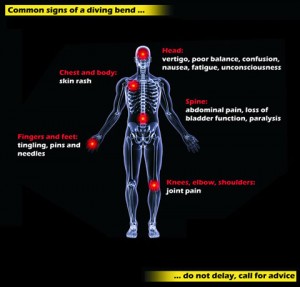Decompression Sickness
Most common with diving accidents, the prevailing theory of DCS is bubble formation when local gas partial pressure exceeds ambient pressure on ascent. This is in spite of observations that bubbles can form without producing DCS and DCS can occur without apparent bubbles. Early detection of DCS is important in the management of DCS as well as other adjunctive therapies. Immediate treatment with Hyperbaric Oxygen Therapy is essential. In the US , DCS therapy is usually by Navy Treatment Tables.Benefits From Hyperbaric Oxygen Treatment
- Volume of bubbles in tissues and blood is reduced immediately according to Boyle's Gas Law. HBOT diffuses gas out of bubbles. Diffusion improves by decreasing inert gas concentration in the inhaled mixture. Oxygen replacing the inert gas in the bubble is consumed metabolically.
- Reduces edema, platelet aggregation, and the coagulation cascade occurring at the blood-bubble interface.
- Blocks white cells from sticking to vessel walls.
- Corrects hypoxia. Oxygen reduces CNS edema and provides a high oxygen gradient for ischemic tissues.
- Aharon-Peretz et al (1993) treated 68 sports divers with DCS. All patients received recompression therapy based on US Navy treatment tables using oxygen. Full recovery was achieved in 79% of these patients.
